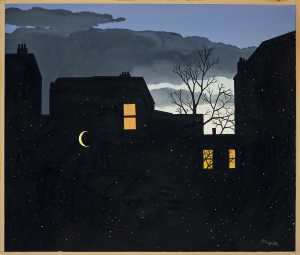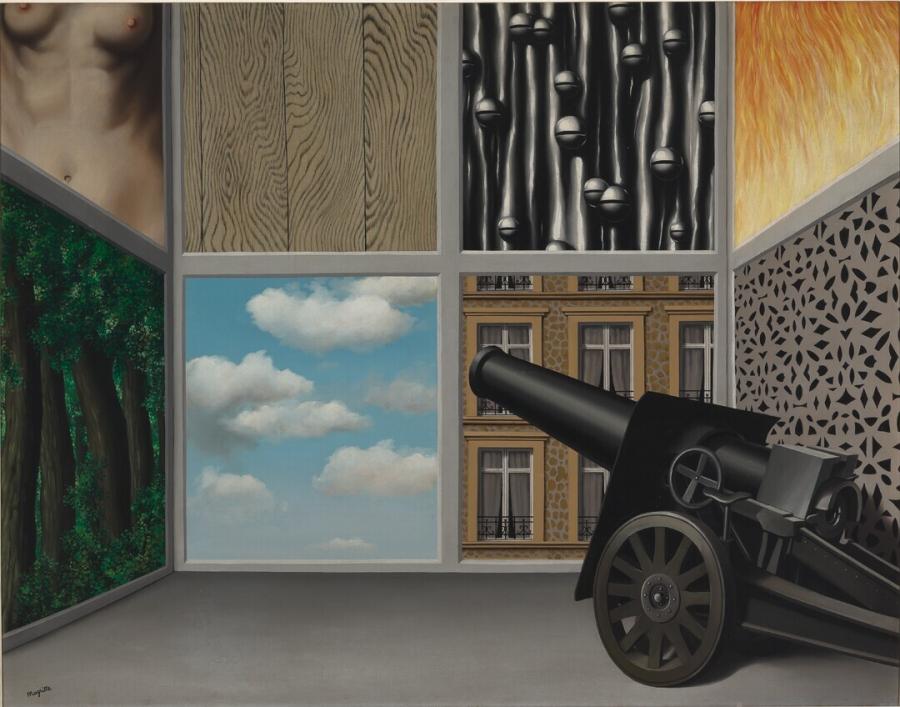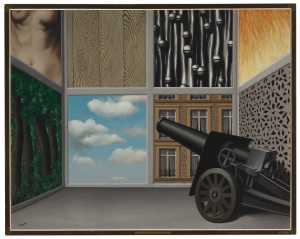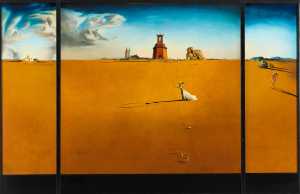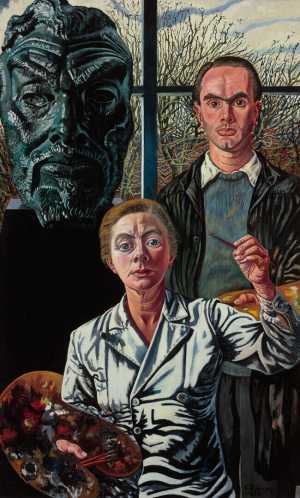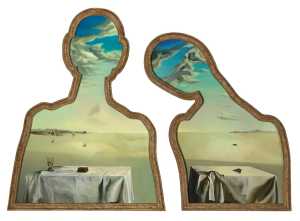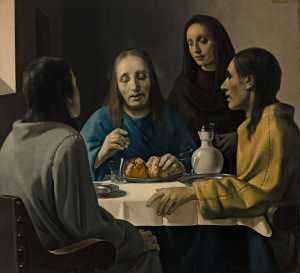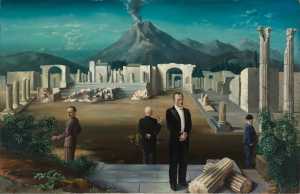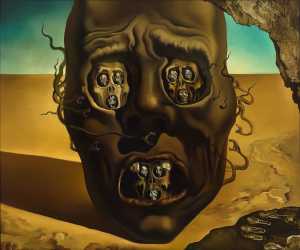The painting shows a canon in a room, the walls of which show various images: clouds, the torso of a woman, several planks, or a façade with windows.
The title of this work by René Magritte was suggested by his friend Paul Nougé. The title is probably borrowed from a quotation from the book Prester John by John Buchnan: 'The clear air of dawn was like wine in my blood. I was not free, but I was on the threshold of freedom'. In fact, the painting is really a promise.

Specifications
| Title | Au seuil de la liberté |
|---|---|
| Material and technique | Oil on canvas |
| Object type |
Painting
> Painting
> Two-dimensional object
> Art object
|
| Location | This object is in storage |
| Dimensions |
Width 146 cm Height 114 cm |
|---|---|
| Artists |
Artist:
René Magritte
|
| Accession number | 2709 (MK) |
| Credits | Purchased 1966 |
| Department | Modern Art |
| Acquisition date | 1966 |
| Creation date | in 1930 |
| Provenance | E.L.T. Mesens, London 1930-36; Humphrey Jennings, London 1936-50; Anthony Hubbard, London 1950-55; J.B. Urvater, Sint-Genesius-Rode 1955-65; Museum Boijmans Van Beuningen Foundation, Rotterdam 1965-66 |
| Exhibitions | Brussels 1931a; Brussels 1931b; Brussels 1931c; Antwerp 1935; London 1936a; Charleroi 1956; Otterlo/Liège 1957; Humlebaek/Brussels 1967; Rotterdam 1967b; Stockholm 1967; New York/Los Angeles/Chicago 1968; London 1969; Humlebaek 1983; Lausanne/Munich 1987-88; Rotterdam 1996a; Brussels 1998; Paris/Düsseldorf 2002; London/Rotterdam/Bilbao 2007-08; New York/Houston/Chicago 2013-14; Edinburgh/Hamburg/Rotterdam 2016-17 |
| Internal exhibitions |
Een prikkelcollectie (2000) The Collection Enriched (2011) Gek van surrealisme (2017) De collectie als tijdmachine (2017) |
| External exhibitions |
De Chirico in Ferrara 1915-1918. Metaphysical Painting and European Avant-garde (2015) Surreal Encounters - Collecting the Marvellous (2016) Dalí, Ernst, Miró, Magritte... (2016) Dal nulla al sogno (2018) Only the Marvelous is Beautiful (2022) A Surreal Shock. Masterpieces from Museum Boijmans Van Beuningen (2023) Histoire de ne pas rire. Le surréalisme en Belgique (2024) Dalí, Magritte, Man Ray and Surrealism. Highlights from Museum Boijmans Van Beuningen (2023) A Surreal Shock – Masterpieces from Museum Boijmans Van Beuningen (2021) Magritte: The Mystery of the Ordinary 1926-1938 (2013) Surrealist Art - Masterpieces from Museum Boijmans Van Beuningen (2021) |
| Research |
Show research A dream collection - Surrealism in Museum Boijmans Van Beuningen |
| Literature | Rotterdam 1967, pp. 90-91, cat. no. 29; New York/Los Angeles/Chicago 1968, p. 93, fig. 124; Hammacher 1973, p. 98; Brussels 1978, p. 176, cat. no. 99; Sylvester 1992a, pp. 185-91; Sylvester 1992b, pp. 347-48, cat. no. 326; Brussels 1998, p. 113; London/Rotterdam/Bilbao 2007-08, pp. 43, 278-79, cat. no. 12, fig. 3.4; New York/Houston/Chicago 2013-14, pp. 198-99, fig. 117; Alechinsky/Jacqmain/Roberts-Jones 2013, pp. 60-61, 81, 87; Edinburgh 2016, pp. 200, 215, 248, cat. no. 91 |
| Material | |
| Object | |
| Geographical origin | Belgium > Western Europe > Europe |
Entry catalogue A dream collection - Surrealism in Museum Boijmans Van Beuningen
Author: Marijke Peyser

René Magritte made this version of Au seuil de la liberté in 1930 for his first solo exhibition in Galerie Goemans in Paris, where he lived from September 1927 to July 1930. Unfortunately the exhibition was cancelled: the gallery did not survive the crisis that followed the global stock market crash of October 1929 and had to close its doors.[1] Les six éléments (The Six Elements), a work made in 1929, is a ‘run-up’ to Au seuil de la liberté: a horizontal canvas that is divided into six parts and contains images that are like those in Au seuil de la liberté.
Magritte described Au seuil de la liberté to his friend the art dealer E.L.T. Mesens in a letter dated 10 June 1930: ‘Room with walls made up of sky, fire, a paper cut-out, a house façade, a woman’s breasts, forest, planks. On the floor stands a large canon aimed at these things.’[2] The title probably refers to a passage from a French translation of John Buchan’s novel Prester John (1927): ‘The clear air of dawn was like wine in my blood. I was not free, but I was on the threshold of freedom.’[3] The scenes in the eight panels depicted on the canvas refer to different traditional genres and painting techniques. The sky and the woods reference landscape painting. The female torso alludes to the nude; the façade to townscapes. Magritte expert Bram Hammacher believes that the three ‘walls’ of Au seuil de la liberté depict a number of aspects from nature and things from man’s everyday life.[4]
Au seuil de la liberté was shown at the International Surrealist Exhibition in London in 1936. The exhibition introduced Surrealism into Great Britain. It was where the English patron and collector Edward James got to know Magritte and saw his work. Six months later James invited the artist to make a triptych in his house in London. In an improvised studio Magritte painted a larger and more vertical version of Au seuil de la liberté, which forms the middle panel of the triptych.[5] The 1930 version was acquired for Museum Boijmans Van Beuningen in 1966, along with Max Ernst’s Le couple and Giorgio de Chirico’s Il trovatore from the collection of the Belgian collectors Bertie and Gigi Urvater (see Le couple and Il trovatore).[6] Later many more Surrealist purchases would follow, including a number of prominent works by Salvador Dalí and Magritte from James’s former collection.
Footnotes
[1] Gibson 1997b, p. 258.
[2] Sylvester 1992b, pp. 347-48: The remark about the size of the canon (bearing Magritte’s signature) refers to a number of allusions in letters from Magritte to friends to the ‘canon bibitale/my private gun’.
[3] Ibid., p. 348.
[4] Hammacher 1995, p. 98.
[5] Gassner in Rotterdam 2017, p. 175, fig. 33.
[6] See Van Kampen-Prein in this publication, pp. 24-25.
All about the artist
René Magritte
Lessen 1898 - Schaarbeek 1967
René Magritte studied at the academy in Brussels. He began as pattern designer in a carpet factory and as painter by painting and designing advertising posters...
Bekijk het volledige profiel

